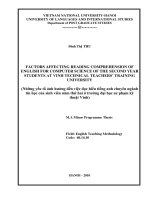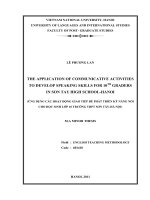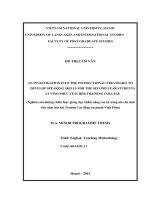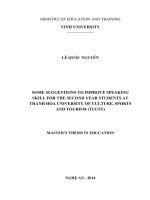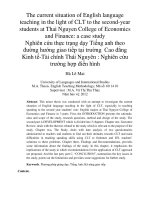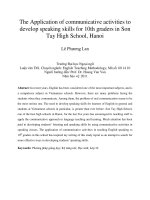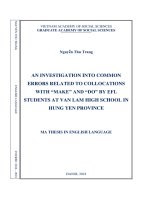INVESTIGATION INTO THE INSTRUCTIONAL STRATEGIES TO DEVELOP SPEAKING SKILLS FOR THE SECOND YEAR STUDENTS AT VINH PHUC TEACHER TRAINING COLLEGE
Bạn đang xem bản rút gọn của tài liệu. Xem và tải ngay bản đầy đủ của tài liệu tại đây (1.83 MB, 80 trang )
VIETNAM NATIONAL UNIVERSITY, HANOI
UNIVERSITY OF LANGUAGES AND INTERNATIONAL STUDIES
FACULTY OF POST-GRADUATE STUDIES
****************
ĐỖ THỊ CẨM VÂN
AN INVESTIGATION INTO THE INSTRUCTIONAL STRATEGIES TO
DEVELOP SPEAKING SKILLS FOR THE SECOND YEAR STUDENTS
AT VINH PHUC TEACHER TRAINING COLLEGE
(Nghiên cứu những chiến lược giảng dạy nhằm nâng cao kỹ năng nói cho sinh
viên năm thứ hai Trường Cao đẳng Sư phạm Vĩnh Phúc)
M.A. MINOR PROGRAMME THESIS
Field: English Teaching Methodology
Code: 60.14.01.11
Hanoi – 2014
VIETNAM NATIONAL UNIVERSITY, HANOI
UNIVERSITY OF LANGUAGES AND INTERNATIONAL STUDIES
FACULTY OF POST-GRADUATE STUDIES
****************
ĐỖ THỊ CẨM VÂN
AN INVESTIGATION INTO THE INSTRUCTIONAL STRATEGIES TO
DEVELOP SPEAKING SKILLS FOR THE SECOND YEAR STUDENTS
AT VINH PHUC TEACHER TRAINING COLLEGE
(Nghiên cứu những chiến lược giảng dạy nhằm nâng cao kỹ năng nói cho sinh
viên năm thứ hai Trường Cao đẳng Sư phạm Vĩnh Phúc)
M.A. MINOR PROGRAMME THESIS
Field: English Teaching Methodology
Code: 60.14.01.11
Supervisor: Dr. Tô Thị Thu Hương
Hanoi - 2014
i
DECLARATION
I, Do Thi Cam Van, hereby declare that the work in this thesis is the result of
my own research. It is recognized that should this declaration be found to be false,
disciplinary actions could be taken and penalties could be imposed in accordance
with university policies and rules.
Hanoi, 2014
Đ Th Cm Vân
ii
ACKNOWLEDGEMENTS
I would love to express my sincere thanks to a number of people whose
invaluable support and encouragement were of great help in completing of this
study.
First of all, I would like to advance my special gratitude to Dr. To Thi Thu
Huong - my supervisor for her guidance, invaluable advice as well as critical
comments during the research process. Without her tireless help, this study could
not have been finished.
Secondly, my thanks go to Dr. Le Van Canh for his contributions through
giving me helpful advice when I started the study.
I am thankful to all the staff of the Post- Graduate Department of University
of Language International Studies, VNU for giving me assistance and encouraging
me to complete the thesis
A further acknowledgement goes to my dear friends from the Master's
Course.
I would also like to acknowledge the 15 English teachers and 60 second -year
students from K17, English Department, Vinh Phuc Teacher Training College for
their participation and cooperation during the data collection process.
Finally, special words of thanks are sent to my beloved family for their
encouragement even in the hardest time when I was confused and exhausted.
iii
ABSTRACT
The study is entitled “An investigation into the instructional strategies to
develop speaking skills for the second year students at Vinh Phuc Teacher
Training College”. It was conducted to examine the second year students’
difficulties in their English speaking skills, find out the instructional strategies
applied by English language teachers in speaking classes, and show how role- play
practice affecting students’ performance in speaking skills. The study was carried
out on sixty second- year students and fifteen English teachers at Vinh Phuc
Teacher Training College during 8 weeks by questionnaires, semi- structured
interviews, test, and personal observations. The findings indicated students’ good
awareness and varied attitudes towards the problems they have to face, and the
difficulties they had in the learning process. In addition, the study showed a range
of the instructional strategies the teachers applied to motivate their students’
participation in speaking lessons. And role- playing was the most popularly used at
Vinh Phuc Teacher Training College.
iv
TABLE OF CONTENTS
Declaration ……………………………………………………………… i
Acknowledgements ii
Abstract iii
Table of contents iv
List of appendices vi
List of abbreviations vii
List of figures vii
List of tables viii
INTRODUCTION
1. Rationale 1
2. Scope of the study 2
3. Aims of the study 2
4. Significance of the study 3
5. Methods of the study 3
6. Design of the study 4
DEVELOPMENT
CHAPTER 1: LITERATURE REVIEW
1. Overview of speaking skills 5
1.1 Definition of speaking and teaching speaking skills 5
1.2 Principles for teaching speaking skills 5
2. Communicative Language Teaching Today 7
2.1 Definition of communicative language teaching 7
2.2 Current trends in communicative language teaching 8
2.3 Classroom activities in communicative language teaching 9
3. Instructional strategies 10
3.1 Definition 10
3.2 Instructional strategies model 11
4. Role- play 13
v
CHAPTER 2: METHODOLOGY
1. The context 15
1.1 Description of the English speaking classe and its objectives at
Vinh Phuc Teacher Training College 15
1.2 Description of the students 17
1.3 Description of the teachers 17
2. Method and procedure 18
2.1 Selection of participants 18
2.2 Data collection methods 18
2.2.1 Questionnaires 19
2.2.2 Semi-structured interviews 19
2.2.3 Observations 20
2.3 Data collection procedures 20
CHAPTER 3: FINDINGS AND DISCUSSION
1. Teachers’ instructional strategies in English speaking classes 22
1.1 Instructional strategies used by teachers in speaking lessons 22
1.2 Which instructional strategies help the students to overcome their
difficulties in speaking lessons? 29
1.2.1 Students’ difficulties in the speaking classes 30
1.2.2 Which instructional strategies help the students to overcome their
difficulties in speaking lessons? 33
2. Effect of role- play practice to students’ performance in English
speaking classes 33
CONCLUSION
1. Summary of the study 39
2. Limitations of the study 39
4. Suggestions for further studies 40
REFERENCES 41
APPENDICES I
vi
LIST OF APPENDICES
Appendix 1: Transcripts of student interviews (schedule 1)
Appendix 2: Transcripts of student interviews (schedule 2)
Appendix 3: Transcripts of teacher interviews (schedule 1)
Appendix 4: Transcripts of teacher interviews (schedule 2)
Appendix 5: Teacher interview schedules
Appendix 6: Student interview schedules
Appendix 7: Mid- term test
Appendix 8: Mid- term test: K 17 English A
Appendix 9: Mid- term test: K 17 English C
Appendix 10: Students’ questionnaire
Appendix 11: Teachers’ questionnaire
Appendix 12: Findings from observation
vii
LIST OF ABBREVIATIONS
ED: English Department
EFL: English as a Foreign Language
CLT: Communicative Language Teaching
MA: Master of Arts
PhD: Doctor of Philosophy
Q: Question
S: Student
T: Teacher
VTTC: Vinh Phuc Teacher Training College
LIST OF FIGURES
Figure 1: Importance of the teachers’ instructional strategies from the teachers’
points of view
Figure 2: Instructional strategies the teachers applied in English speaking lessons
Figure 3: The instructional strategy motivated the students the most in English
speaking lessons
Figure 4: Importance of the teachers’ instructional strategies from the students’
points of view
Figure 5: Instructional strategies the teachers used from the students’ points of view
Figure 6: Instructional strategy motivated the students the most from the students
Figure 7: Students’ difficulties in English speaking lessons
Figure 8: Students’ difficulties from the teachers’ points of view
Figure 9: Students’ result from the mid- term test
viii
LIST OF TABLES
Table 1: Speaking activities and topics designed for the second year English
majored students
Table 2: Importance of the teachers’ instructional strategies from the teachers’
points of view
Table 3: The instructional strategies the teachers applied and which instructional
strategy motivated the students the most in English speaking lessons
Table 4: Importance of the teachers’ instructional strategies from the students’
points of view
Table 5: The instructional strategies the teachers applied and which instructional
strategy motivated the students the most in English speaking lessons from the
students’ points of view
Table 6: Students’ difficulties in English speaking lessons
Table 7: Students’ difficulties in English speaking lessons from the teachers’ points
of view
Table 8: Students’ perceptions towards role- play
Table 9: Students’ result from the mid- term test
1
PART A: INTRODUCTION
This part of the thesis is dedicated to introducing the rationale, the aims, the
scopes and the significance of the study as well as the research questions. It also
presents the research method and the design of the study.
1. Rationale
At present, Vietnamese people consider English to be an important foreign
language, and thus, a great number of people study it. In the context of global
integration, in general, and in Viet Nam in particular, the demand for learning English
gets stronger and stronger power. This worldwide expansion has increased the demand
to acquire good communication skills in English. That is the reason why the teaching
and learning English has been paid more attention recently in Vietnam. English is
regarded as an indispensable tool for academic and career advancement. It cannot be
denied, therefore, that English is now the dominant language, especially in language
teaching programs in many schools.
In the era of communicative language teaching, teaching and learning the four
language skills are inevitable (Bailey, 1998). Of four major language skills, the mastery
of speaking skills is put on the first priority by many Vietnamese learners. This is
because the success of learners in language learning is often evaluated on the
improvement in their spoken language proficiency (Richards, 2006). In order to aid
teachers and learners in their teaching and learning speaking skills, there is a variety of
speaking instructional techniques available. In addition, Shumin (1997) stated that
learning to speak a foreign language requires more than knowing its grammar and
vocabulary. The ways the teachers teach English can affect the academic achievement
of the learners especially at higher level.
Nunan (1998) argued that it is very important for the teachers to be aware that
motivation is a consideration in determining whether or not learners are willing to
2
communicate. Clearly, the more meaningful the materials, the tasks and the teachers’
instructional strategies are for the learners involved, the better the outcome will be.
Ur (2005) developed this further by suggesting that good speaking skills
classrooms are ones where learners talk a lot, participation is even, motivation is high
and the language is at an acceptable level.
Ur (1991) reminded motivation is one of the most important matters for the class
teachers and suggested that “learners motivation makes teaching and learning
immeasurably easier and more pleasant, as well as more productive” (Ur 1991: 274)
Furthermore, in the process of learning English speaking skills, the second year
English majored students at VTTC often express a feeling of stress, nervousness or
anxiety, in-confidence… In addition, their results in the final speaking examinations
are usually low. This fact can be triggered to many difficulties the students have to face
in their learning process. In order to help the second year English majored students to
overcome their difficulties in learning speaking skills, and help the English teachers to
have some useful instructional strategies in teaching are the inspiration of conducting
the study entitled “An investigation into the instructional strategies to develop
speaking skills for the second year students at Vinh Phuc Teacher Training
College”.
2. Scope of the study
As this thesis is only a small-sized scale study, it is only concerned with the
difficulties the students had in the speaking class, the suitable instructional strategies
that teachers at VTTC choose for the second year English majored students in their
speaking lessons as well as to help the students learn English speaking skills better.
3. Aims of the study
The study is carried out to help the English teachers at VTTC find out which
instructional strategies are suitable in the actual context of teaching English speaking
skills at VTTC. Firstly, the thesis is an attempt to explore the instructional strategies
3
being applied by English language teachers by questionnaires, interviews, and
observation so as to see which instructional strategies help the students to overcome
their difficulties in English speaking lessons. Secondly, the study investigated the
effectiveness of role- play practice to students’ English speaking performance.
In order to achieve the aims mentioned above, the study is designed to answer the
following research questions:
(1) What are the instructional strategies applied by the English language
teachers in speaking classes at VTTC?
1.1. What instructional strategies are commonly used by the English
language teachers in their speaking lessons?
1.2. Which instructional strategies help the students to overcome their
difficulties in speaking lessons?
(2) How well can role- play practice help the students to overcome their
difficulties in speaking lessons?
4. Significance of the study
This study plays an important role to the author herself as well as to teachers
teaching English speaking skills, it provides teachers with necessary and important
information to help them choose the most suitable instructional strategies that have
high value in helping students to speak English.
5. Methods of the study
This study focused on finding out the instructional strategies in teaching English
speaking skills to the second year English majored students. A survey method was
employed to collect the data. In order to seek answers to the above research questions,
the questionnaires were designed and delivered to 15 English teachers and 60 second
year English majored students. Besides, with the hope that the reliability of the
obtained information from the questionnaires would increase, semi-structured
interviews with the second year English majored students and the English language
4
teachers were carried out. The researcher also observed the classes to have more
information. At the end of research process, the author designed a mid- term test to
check the students’ speaking performance.
6. Design of the study
The study is divided into three parts named introduction, development and
conclusion. Part A is introduction which provides an overview of the study including
the rationale, the aims, the research questions, the scope, the significance, the research
method as well as the design of study. The second part, development has three
chapters. Chapter 1 deals with literature review. This chapter reviews theoretical
background on which the whole study is based. Chapter 2 is about Methodology, which
briefly presents the methodological framework of the study. It includes the setting, the
subjects, the instruments and procedure of data collection and data analysis. Chapter 3
presents data analysis, findings, discussion and brings some more useful strategies used
in speaking lessons. The last part, Conclusion, presents the summary of the study,
limitations and suggestions for further studies.
5
PART B: DEVELOPMENT
CHAPTER I: LITERATURE REVIEW
In the investigation into the instructional strategies to develop students’ speaking
abilities, the study needs to present the previous and current literature on the speaking
skills. Besides, it should show the definition of the instructional strategy used by the
English language teachers in speaking lessons, and then define and explore the nature
of speaking. Next, the definition and current trends of Communicative Language
Teaching (CLT) is also analyzed. These issues are mentioned specifically in the first
chapter.
1. An overview of speaking skills
1.1. Definition of speaking and teaching speaking skills
Of the four skills (listening, speaking, reading, writing), speaking plays a vital role
since it is the step to identify who knows or does not know a language. Pattison (1992)
confirms that when people know or learn a language, they mean being able to speak the
language. Speaking, according to Donough and Shaw (1993), is a skill which enables
people to produce utterances when communicating to achieve a particular end.
Defining the term “speaking”, Florez (1999, cited in M.Bailey, 2005) states that
speaking is “an interactive process of constructing meaning that involves producing,
receiving and processing information”. In this process, there are five elements involved
including pronunciation, vocabulary, grammar, gesture and mimics, fluency and
accuracy (Harmer, 2001). In the process of teaching and learning a foreign language,
teaching speaking skills means helping students develop the ability to produce
grammatically correct and logically connected utterances that are appropriate in
specific contexts with acceptable pronunciation (Fararwati, 2010).
1.2. Principles for teaching speaking skills
When teaching speaking, there are some principles that teachers should follow to
ensure the effectiveness of speaking lessons. Such principles are discussed in the works
6
of some famous linguists. Nunan (1991: 55, 56) suggested five principles for teaching
speaking skills as follow:
- Be aware of the difference between second language and foreign language learning
contexts.
- Give students practice with both fluency and accuracy.
- Provide opportunities for students to talk by using group works or pair works and
limiting teacher talk.
- Plan speaking tasks that involve negotiation for meaning.
- Design classroom activities that involve guidance and practice in both transactional
and interactional speaking in which transactional speech involves communicating to
get something done and interactional speech is communicating with someone for social
purpose, establishing and maintaining social relationships.
Brown (1994) mentioned six principles for teaching speaking skills
- Focus on both fluency and accuracy
- Provide intrinsically motivating techniques.
- Encourage the use of authentic language.
- Provide appropriate feedback and correction.
- Capitalize on the natural link between speaking and listening.
- Give students opportunities to initiate oral communication.
(Source: Slides by Daniel Beck- )
The opinions of the two authors have some differences but they share one
common principle is that the teachers should focus on fluency and accuracy when
teaching speaking skills. In the definition of Richards (2006:14), “Fluency is natural
language use occurring when a speaker engages in meaningful interaction and
maintains comprehensible and ongoing communication despite limitations in his or her
communicative competence” while “accuracy focuses on creating correct examples of
language use.” Thus, we cannot say that someone can speak fluently without accuracy
7
or vice versa, and accuracy as well as fluency is very necessary for successful
communication/ presentation.
Nunan (2003: 55) also states that “Accuracy is the extent to which students’
speech matches what people actually say when they use the target language. Fluency is
the extent to which speakers use the language quickly and confidently, with few
hesitations or unnatural pauses, false starts, word searches, etc.”. As for Ur (1996),
both fluency and accuracy are taken into consideration, apart from other factors. This is
a good balance. Brown (1994: 254) also shares the same idea that “both fluency and
accuracy are important goals to pursue in CLT”.
In our own situation, most of the second-year majors seem to lack confidence in
speaking/ presenting in English. Nonetheless, what they talk about is more important
than what they achieve. Thus, the teachers should tolerate and encourage the students
to feel safer and be more confident to present more effectively.
2. CLT Today
The ever growing need for good communication skills in English has created a
huge demand for English teaching around the world. Millions of people today want to
improve their command of English or to ensure that their children achieve a good
command of English.
2.1. Definition of CLT
Perhaps the majority of language teachers today when asked to identify the
methodology they employ in their classrooms mention “communicative” as the
methodology of choice.
Richard, J. (2006) defines that CLT can be understood as a set of principles about
the goals of language teaching, how learners learn a language, the kinds of classroom
activities that best facilitate learning, and the roles of teachers and learners in the
classroom. CLT sets as its goal the teaching of communicative competence.
8
Richards and Rodgers (2001) said that CLT is generally regarded as an approach
to language teaching. So, CLT reflects a certain model or research paradigm, or a
theory (Celce Murcia, 2001). Its primary goal is for learners to develop communicative
competence or communicative ability (Hymes, 1971).
CLT is learner-centered and emphasizes communication and real- life situations.
In traditional methods of English teaching, the teacher is the expert and carries the
responsibility for students’ learning.
In CLT, learners practice real- life situations, for example, asking someone for
directions. Learners communicate their thoughts without worrying about perfect
grammar.
CLT methodologies are best described as a set of macro- strategies
(Kumaradivelu, 1994) or methodological principles (Doughty and Long, 2003).
2.2. Current trends in CLT
Approaches to language teaching today seek to capture the rich view of language
and language learning assumed by a communicative view of language. Jacob and
Farrell (2001: 3) see the shift toward CLT as marking a paradigm shift about teachers,
learning, and teaching. Some components of this shift mentioned as follow:
- Focusing attention on the role of the learners rather than the external stimuli
learners are receiving from their environment. So the center of attention in the
classroom shifted from the teacher to the student. This process is generally known as
the move from teacher-centered instruction to learner-centered instruction.
- Focusing attention on the learning process rather than the products that learners
produce. This shift is known as the move from product-oriented to process- oriented
instruction.
- Focusing attention on the social nature of learning rather than on students as
separate, decontextualized individuals.
9
- Focusing attention on diversity among learners and viewing these differences not
as impediments to learning but as resources to be recognized, catered to, and
appreciated. This shift is known as the study of individual differences.
- Helping students to understand the purpose of learning and develop their own
purpose.
- An emphasis on the importance of meaning rather than drills and other forms of
rote learning
- A view of learning as a lifelong process rather than something done to prepare
students for an exam.
2.3. Classroom activities in CLT
Since accessed to CLT, teachers and materials writers have sought to find ways
of developing classroom activities that reflect the principles of a communicative
methodology. Activities that require frequent interaction among learners or with other
interlocutors to exchange information and solve problems (Wesche and Skehan, 2002)
- Information- gap activities
This refers to the fact that in real communication, people norrally communicate to
get information they do not possess. More authentic communication is likely to occur
in the classroom is the students go beyond practice of language forms for their own
sake and use their linguistic and communicative resources to obtain information.
- Jigsaw activities:
The class is divided into groups and each group has part of information needed to
complete an activity. The class must fit the pieces together to complete the whole.
They have to use their language abilities to communicate meaningfully and so take part
in meaningful communication practice.
- Task- completion activities:
Puzzles, games, map reading in which the focus is on using one’s language
resources to complete a task.
10
- Information- gathering activities:
Student- conducted surveys, interviews, and searches in which students are
required to use their linguistic resources to collect information.
- Opinion- sharing activities:
Activities in which students compare values, opinions, or beliefs, such as a ranking
task in which students list qualities iin order of importance that they might consider in
choosing a date or a spouse.
- Information- transfer activities:
These activities require students to take information that is presented in one form,
and represent it in a different form.
- Reasoning- gap activities: These involve deriving some new information from
given information through the process of interfence, practical reasoning,
- Role- play: Activities in which students are assigned roles and improvise a
scene or exchange based on given information or clues.
3. Instructional strategies
3.1. Definition
There have been many definitions of the instructional strategies mentioned in
linguistics. Friedman and Fisher’s (1998) states that instructional strategies are those
tactics used by the instructors to promote learning
Dick and Carey (1996) showed the definition of the instructional strategies:
Instructional strategies determine the approach a teacher may take to achieve learning
objectives. Instructional strategies are used by the teachers to create learning
environment and to specify the nature of the activity in which the teacher and learner
will be involved during the lessons.
Dick and Carey (1996) used the term instructional strategy to describe the process
of sequencing and organizing content, specifying learning activities, and deciding how
to deliver the content and activities.
11
Mentioned in Alberta Learning, (2002: 67), instructional strategies are defined as
the activities the teachers use to help the students become independent, strategic
learners.
The purposes of the instructional strategies are:
- To motivate students and help them focus attention
- To organize information for understanding and remembering
- To monitor and assess learning
(Instructional strategies/ 67/ 2002, Alberta Learning, Alberta, Canada)
3.2. Instructional strategies model of Dick and Carey (1996)
Dick and Carey's Model
Dick and Carey's model (1996) is systematic in nature. The model is a procedural
system including ten major process components (9 basic steps in an iterative cycle and a
culminating evaluation of the effectiveness of the instruction).
The 9 components in an iterative cycle include:
12
- Assess needs to identify instructional goal(s): to identify what it is the learners are
expected to be able to do at the end of the instruction
- Conduct instructional analysis: to determine a step-by-step of what learners are doing
when they are performing the goal; to determine what skills and knowledge are required
- Analyze learners and contexts: to identify learners' present skills, preferences and
attitude as well as the characteristics of the instructional setting, prior knowledge of the
topic area, attitudes toward content and potential delivery systems, academic motivation.
- Write performance objectives: to specify what it is the learners will be able to do with
the statements of the skills to be learned, the conditions, and the criteria
- Develop assessment instruments: to develop a criteria-referenced assessment consistent
with the performance objectives
- Develop instructional strategy: to develop strategies in pre-instructional activities,
presentation of information, learner's participation, testing and follow-through activities
- Develop and select instruction: to use the instructional strategies to produce the
instruction
- Design and conduct formative evaluation: to collect data that are used to identify how to
improve the instruction
- Revise instruction: to use the data from the formative evaluation to examine the validity
of the instructional analysis, learner and context analysis, performance objectives,
assessment instruments, instructional strategies, and instruction.
The final process is to design and conduct summative evaluation, which is an evaluation
of the value of the instruction.
(Dick, W., & Carey, L. (1996). The systematic design of instruction)
Comments from Gustasfon and Branch (1997) about Dick and Carey's (1996) Model:
"The most widely adopted introductory text related to the process is Dick and Carey
(1996). Thus, their model is known almost anywhere English is taught. The popularity of
13
the Dick and Carey model can be partially explained by its very readable text and the
authors' continually updating the model to reflect emerging philosophy. They also
accompany there model with clear and simple examples of each of the steps and excerpts
from cases of its use to provide readers with a frame of reference. Dick and Carey have
made minor modifications to their model to reflect growing interest in performance
technology, context analysis, multilevel evaluation models, and total quality
management".
From the above definitions of the instructional strategies of some linguists and the
model of the instructional strategies of Dick and Carey (1996), I draw my own definition
of the instructional strategies as follows:
The instructional strategies are effective activities the teachers used in the
classroom to achieve the learning objectives. In simple words, the instructional strategies
are the ways or activities the teachers applied to stimulate students to participate in the
learning process.
4. Role- play
It is not enough merely to provide students with opportunities to speak in
English, as teachers we need to encourage students to speak in a variety of different
situations, and hence help them to learn to speak with confidence.
However, many teachers and students in an ESL class dread the words “role-
play”. Just a few of the terms which are used, often interchangeably, are
"simulation," "game," "role-play," "simulation-game," "role-play simulation," and
"role-playing game" (Crookall and Oxford, 1990a).
Role- play is an effective technique to animate the teaching and learning
atmosphere, arouse the interests of learners, and make the language acquisition
impressive.
According to Gower et-al, a role play part of a particular person: a customer, a
14
manager, a shop assistant, for example. As this person, they take part in a situation,
acting out a conversation.
Meanwhile according to Revell, role play defined as an individual’s
spontaneous behavior reacting to others in a hypothetical situation.
The effective use of role-plays can add variety to the kinds of activities students
are asked to perform. It encourages thinking and creativity; lets students develop
and practice new language and behavioural skills in a relatively safe setting, and can
create the motivation and involvement necessary for real learning to occur.
Reasons for using role play in the English speaking classroom
- Role play allows a wider range of language functions and language varieties to occur than
would normally occur within a classroom
- Role play allows exploration of cultural issues, in particular, appropriate ways to behave
in certain situations such as when being offered food or drink.
- Role play can add interest to an activity and by distributing roles can ensure participation
in an activity.
- Role play can result in repetition of speaking activity by providing a change.
Summary: From all the above information, all the readers could see that there were
many useful activities (the instructional strategies) the language teachers can apply in
their English speaking classes to stimulate their students in the learning process. The
linguists mentioned the instructional strategies much in their studies such as group-
work, information gap activities, jigsaw activities, role- play . In the actual context
of VTTC, role- play activities have been applying widely. However, up to present, there
has not been a study relating how role- play activities affecting student’ performance
in the speaking classes at VTTC yet. That was the reason why I chose this aspect to
research.
15
CHAPTER II: METHODOLOGY
1. The context
1.1. Description of the English speaking classes and its objectives at VTTC
The study was conducted at VTTC. The major English students at VTTC are
required to complete four semesters of speaking skills during the first year and the
second year. Each semester includes four credits.
The main course book used for the second year students in the first semester is
Speaking three assigned by the group of English teachers of VTTC to fit students’ level
of English and educational goals of the college. The total number of units is nine.
There are only nine units, each contains a topic and includes a variety of parts such as
grammar, vocabulary, pronunciation, exercises and communicative skills. To be more
detailed, main activities and topics or drills designed in terms of speaking skills in the
course book are presented as the following:
Unit
Topic
Activities
Content
1
Tourism
Pair work
Giving opinions about tourism in Vietnam
Group work
Advantages and disadvantages in developing
tourism in your local area.
Role- play
A tour guide and a visitor
Group work
How to attract tourists to visit landscapes in
your hometown
2
Education
Pair work
Good and bad habits when at school
Group work
Difficulties the Vietnamese Education System
is facing
Role- play
Talk about the school education system in Viet
Nam: An education researcher and a journalist.
Pair work
Give advices to protect your local environment

